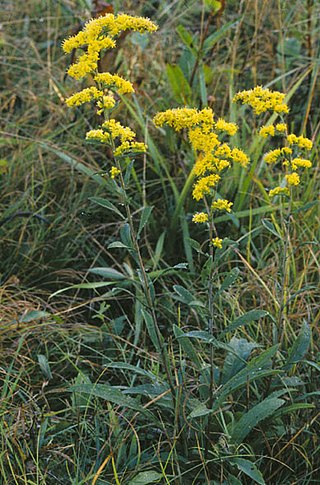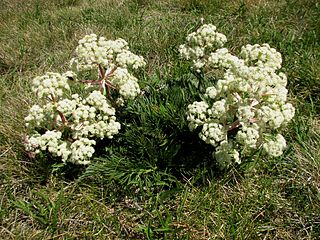
Goldenrod is a common name for many species of flowering plants in the sunflower family, Asteraceae, commonly in reference to the genus Solidago.

Stipa is a genus of around 300 large perennial hermaphroditic grasses collectively known as feather grass, needle grass, and spear grass. They are placed in the subfamily Pooideae and the tribe Stipeae, which also contains many species formerly assigned to Stipa, which have since been reclassified into new genera.

Balsam is the resinous exudate which forms on certain kinds of trees and shrubs. Balsam owes its name to the biblical Balm of Gilead.
Indian millet is a name widely used in different parts of the world to describe a number of different plants. A possibly incomplete list is:
Colic weed is a common name for several plants and may refer to:
Christmas rose is a common name for flowering plants and may refer to:
Sea pink is a common name for several plants and may refer to:
Calla lily is a common name of several members of the family, Araceae. It may refer to:
Honeywort may refer to following plants:

Aciphylla is a genus of about 40 species of herbaceous plants in the family Apiaceae, all but two of them endemic to New Zealand. They range from small cushion plants to tall flower spikes surrounded by rosettes of stiff, pointed leaves, the latter probably adaptations to prevent browsing by moa. Their common name is speargrass or Spaniard. Most Aciphylla species live in subalpine or alpine habitats in the South Island. Fragrant oil extracted from some large species, known as taramea, is still used as a perfume by Māori.

Nassella pulchra, basionym Stipa pulchra, is a species of grass known by the common names purple needlegrass and purple tussockgrass. It is native to the U.S. state of California, where it occurs throughout the coastal hills, valleys, and mountain ranges, as well as the Sacramento Valley and parts of the Sierra Nevada foothills, and Baja California.
The term needlegrass may refer to any of several genera of grasses, including:
Corn lily is a common name for several plants and may refer to:
Helmet-flower is a common name for several plants and may refer to:
Porcupine grass is a common name for several grasses and may refer to:
Bully tree is a common name for several neotropical trees in the family Sapotaceae and may refer to:

The Southland montane grasslands, also known as the South Island montane grasslands, is a montane grasslands and shrublands ecoregion on New Zealand’s South Island. The ecoregion covers the middle portion of the Southern Alps, and includes extensive alpine grasslands, fellfields, and montane forests.

The Central Andean wet puna is a montane grasslands and shrublands ecoregion in the Andes of Peru and Bolivia.
Sand grass or sandgrass is a common name for several plants and may refer to:
Feathergrass is a common name for several plants and may refer to:
This page is based on this
Wikipedia article Text is available under the
CC BY-SA 4.0 license; additional terms may apply.
Images, videos and audio are available under their respective licenses.






